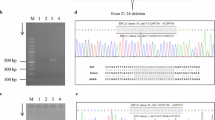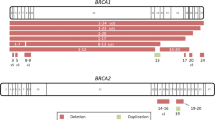Abstract
Women who develop bilateral breast cancer at an early age are likely to harbour germline mutations in breast cancer susceptibility genes. The aim of this study was to test for concordant genetic changes in left and right breast cancer of young women (age <50) with bilateral breast cancer that may suggest an inherited breast cancer predisposition. Microsatellite markers were used to test for loss of heterozygosity (LOH) in left and right tumours for 31 women with premenopausal bilateral breast cancer. Markers adjacent to or within candidate genes on 17p (p53), 17q (BRCA1), 13q (BRCA2), 11q (Ataxia Telangiectasia-ATM) and 3p (FHIT) were chosen. Mutational testing for BRCA1 and BRCA2 was performed for cases where blood was available. Concordant LOH in both left and right tumours was demonstrated for at least one of the markers tested in 16/31(54%) cases. Where allelic loss was demonstrated for both left and right breast cancer, the same allele was lost on each occasion. This may suggest a common mutational event. Four cases showed concordant loss of alleles in both left and right breast cancer at D17S791 (BRCA1). BRCA1 mutations were identified in two of these cases where blood was available. Four cases showed concordant LOH at D13S155 (BRCA2). Concordant LOH was further demonstrated in seven cases for D11S1778 (ATM) and four cases for D3S1300 (which maps to the FHIT gene), suggesting a possible role for these tumour suppressor genes in this subgroup of breast cancer patients. No concordant allelic loss was demonstrated for D17S786 suggesting that germline mutations in p53 are unlikely in such cases of bilateral breast cancer.
Similar content being viewed by others
References
Knudson AG, Jr: Mutation and cancer: statistical study of retinoblastoma. Proc Natl Acad Sci USA 68: 820-823, 1971
Smith SA, Easton DF, Evans DGR, Ponder BAJ: Allele losses in the region 17q12-21 in familial breast and ovarian cancer involve the wild-type chromosome. Nature Genet 2: 128-131, 1992
Tsuda H, Hirohashi: Identification of multiple breast cancers of multicentric origin by histological; observations and distribution of allele loss on chromosome 16q. Cancer Res 55: 3395-3398, 1995
Schildkraut JM, Collins NK, Dent GA, Tucker JA, Barrett JC, Berchuck A, Boyd J: Loss of heterozygosity on chromosome 17q11-21 in cancers of women who have both breast and ovarian cancer. Am J Obstet Gynaecol 172: 908-913, 1995
Anderson DE: Genetic study of breast cancer: identification of a high risk group. Cancer 34: 1090-1097, 1974
Anderson DE, Badzioch MD: Bilaterality in familial breast cancer patients. Cancer 56: 2092-2098, 1985
Ottman R, Pike MC, King M-C, Casagrande JT, Henderson BE: Familial breast cancer in a population-based series. Am J Epidemiol 123: 15-21, 1986
Elston CW, Ellis IO: Pathological prognostic factors in breast cancer. I. The value of histological grade in breast cancer: experience from a large study with long term follow-up. Histopathology 19: 403-410, 1991
Ellis IO, Galea MH, Broughton N, Locker A, Blamey RW, Elston CW: Pathological prognostic factors in breast cancer. II. Histological type. Relationship with survival in a large study with long term follow-up. Histopathology 20: 479-489, 1992
Chaudary MA, Millis RR, Hoskins EOL, Halder M, Bulbrook RD, Cuzick J, Hayward JL: Bilateral primary breast cancer: a prospective study of disease incidence. Br J Surg 71: 711-714, 1984
Malkin D, Li FP, Strong LC, Fraumeni JF Jr, Nelson CE, Kim DH, Kassel J, Gryka MA, Bischoff FZ, Tainsky MA, Friend SH: Germline p53 mutations in cancer families. Science 250: 1233-1238, 1990
Miki Y, Swensen J, Shattuck-Eidens D, Futreal PA, Harshman K, Tavtigian S, Liu Q, Cochran C, Bennett LM, Ding W, Bell R, Rosenthal J, Hussey C, Tran T, McClure M, Frye C, Hattier T, Phelps R, Haugen-Strano A, Katcher H, Yakumo K, Gholami Z, Shaffer D, Stone S, Bayer S, Wray C, Bodgen R, Dayananth P, Ward J, Tonin P, Narod S, Bristow PK, Norris FH, Helvering L, Morrison P, Rosteck P, Lai M, Barrett JC, Lewis C, Neuhausen S, Cannon-Albright L, Goldgar D, Wiseman R, Kamb A, Skolnick MHA: A strong candidate for the breast and ovarian cancer susceptibility gene BRCA1. Science 266: 66-71, 1994
Wooster R, Bignell G, Lancaster J, Swift S, Seal S, Mangion J, Collins N, Gregory S, Gumbs C, Micklem G, Barfoot R, Hamoudi R, Patel S, Rice C, Biggs P, Hashim Y, Smith A Connor F, Arason A, Gudmundsson J, Ficenec D, Kelsell D, Ford D, Tonin P, Bishop DT, Spurr NK, Ponder BAJ, Eeles R, Peto J, Devilee P, Cornelisse C, Lynch H, Narod S, Lenoir G, Egilsson V, Barkardottir RB, Easton DF, Bentley DR, Futreal PA, Ashworth A, Stratton MR: Identification of the breast cancer susceptibility gene BRCA2. Nature 378: 789-792, 1995
Savitsky K, Bar-Shira A, Gilad S, Rotman G, Ziv Y, Vanagaite L, Tagle DA, Smith S, Uziel T, Sfez S, Ashkenazi M, Pecker I, Frydman M, Harnik R, Patanjali SR, Simmons A, Clines GA, Sartiel A, Gatti RA, Chessa L, Sanal O, Lavin MF, Jaspers NGJ, Taylor AMR, Arlett CF, Miki T, Weissman SM, Lovett M, Collins FS, Shiloh Y: A single Ataxia Telengiectasia gene with a product similar to PI-3 kinase. Science 268: 1749-1752, 1995
Otah M, Inoue H, Cotticelli MG, Kastury K, Baffa R, Palazzo J, Siprashvili Z, Mori M, McCue P, Druck T, Croce CM, Huebner K: The FHIT gene, spanning the chromosome 3p14.2 fragile site and renal associated t(3;8) breakpoint, is abnormal in digestive tract cancers. Cell 84: 587-597, 1996
Man S, Ellis IO, Sibbering DM, Blamey RW, Brook JD: High levels of allele loss at the FHIT and ATM genes in non-comedo ductal carcinoma in situ and grade I tubular invasive breast cancers. Cancer Res 56: 5484-5489, 1996
Gayther SA, Harrington P, Russel P, Kharkevich G, Garkavtseva RF, Ponder BA, UKCCCR Familial Ovarian Cancer Study Group: Rapid Detection of regionally clustered germline BRCA1 mutations by multiplex heteroduplex analysis. Am J Hum Genet 58: 451-456, 1996
Plummer SJ, Anton-Culver H, Webster L, Noble B, Liao S, Kennedy A, Belinson J, Casey G: Detection of BRCA1 mutations by the protein truncation test. Hum Mol Genet 4(10): 1989-1991, 1995
Serova OM, Mazoyer S, Puget N, Dubois V, Tonin P, Shugart YY, Goldgar D, Narod SA, Lynch HT, Lenoir GM: Mutations in BRCA1 and BRCA2 in breast cancer families: are there more breast cancer-susceptibility genes? Am J Hum Genet 60(3): 486-495, 1997
Easton DF, Bishop DT, Ford D, Crockford GP, The Breast Cancer Linkage consortium: Genetic linkage analysis in familial breast and ovarian cancer: results in 214 families. Am J Hum Genet 52: 678-701, 1993
Wooster R, Neuhausen SL, Mangion J, Quirk J, Ford D, Collins N, Nguyen K, Seal S, Tran T, Averill D, Fields P, Marshall G, Narod S, Lenoir G, Lynch H, Feunteun J, Devilee P, Cornelisse C, Menko FH, Daly PA, Ormiston W, McManus R, Pye C, Lewis CM, Cannon-Albright LA, Peto J, Ponder BAJ, Skolnick MH, Easton DF, Goldgar DE, Stratton MR: Localisation of a breast cancer susceptibility gene BRCA2, to chromosome 13q12-13. Science 265: 2088-2090, 1994
Futreal PA, Soderquist P, Marks JR, Iglehart JD, Cochran C, Barrett JC, Wiseman R: Detection of frequent allelic loss on proximal chromosome 17q in sporadic breast carcinoma using microsatellite length polymorphisms. Cancer Res 52: 2626-2627, 1992
Futreal PA, Liu Q, Shattuck-Eidens D, Cochran C, Harshman K, Tavtigian S, Bennett LM, Haugen-Strano A, Swensen J, Miki Y, Eddington K, McClure M, Frye C, Weaver-Feldhaus, Ding W, Gholami Z, Soderkvist P, Terry L, Jhanwar S, Berchuck A, Inglehart JD, Marks J, Ballinger DG, Barrett JC, Skolnick M, Kamb A, Wiseman R: BRCA1 mutations in primary breast and ovarian carcinomas. Science 266: 120-122, 1994
Langston AA, Malone KE, Thompson JD, Daling JR, Ostrander EA: BRCA1 mutations in a population-based sample of young women with breast cancer. N Engl J Med 334: 137-142, 1996
Krainer M, Silva-Arrieta S, Fitzgerald MG, Shimada A, Ishioka C, Kanamaru R, MacDonald DJ, Unsal H, Finketstein DM, Bowcock A, Isselbacher KJ, Haber DA: Differential contributions of BRCA1 and BRCA2 to early-onset breast cancer. N Engl J Med 336: 1416-1421, 1997
Marcus JN, Watson P, Page DL, Narod SA, Lenoir GM, Tonin P, Linder-Stevenson L, Salerno G, Conway TA, Lynch HT: Hereditary breast cancer — Pathobiology, prognosis, and BRCA1 and BRCA2 gene linkage. Cancer 77: 697-709, 1996
Jacquemier J, Eisenger F, Birnbaum D, Sobol H: Histoprognostic grade in BRCA1-asscociated breast cancer. Lancet 345: 1503, 1995
Bignon Y-J, Fonck Y, Chassagne M-C: Histoprognostic grade in tumours from families with hereditary predisposition to breast cancer. Lancet 346: 258, 1995
Cleton-Jansen A-M, Collins N, Lakhani SR, Weissenbach J, Devilee P, Cornelisee CJ, Stratton MR: Loss of heterozygosity in sporadic breast tumours at the BRCA2 locus on chromosome 13q12-q13. Br J Cancer 72: 1241-1244, 1995
Ramus SJ, Freidman LS, Gayther SA, Ponder BAJ, Bobrow JG, Van der Looji M, Papp J, Olah E: A breast/ovarian cancer patient with germline mutations in both BRCA1 and BRCA2. Nature Genet 15: 14-15, 1997
Kelsell DP, Spurr NK, Barnes DM, Gusterson B, Bishop DT: Combined loss of BRCA1/BRCA2 in grade 3 breast carcinomas. Lancet 347: 1554-1555, 1996
Kote-Jarai Z, Eeles RA: BRCA1, BRCA2 and their possible function in DNA damage response. Br J Cancer 81(7): 1099-1102, 1999
Swift M, Morrell D, Cromartie E, Chamberlain AR, Skolnick MH, Bishop DT: The incidence and gene frequency of ataxia-telangiectasia in the United States. Am J Hum Genet 39: 573-583, 1986
Swift M, Morrell D, Massey RB, Chase CL: Incidence of cancer in 161 families affected by ataxia-telangiectasia. N Engl J Med 325: 1831-1836, 1991
Hampton MM, Mannermaa A, Winquist R, Alavaikko M, Blanko G, Taskinen PJ, Kiviniemi K, Newsham I, Cavenee WK, Evans GA: Loss of heterozygosity in sporadic human breast carcinoma: A common region between 11q22 and 11q23.3. Cancer Res 54: 4586-4589, 1994
Carter SL, Negrini M, Baffa R, Gillum DR, Rosen berg AL, Schwarz GF, Croce CM: Loss of hetreozygosity at 11q22-q23 in breast cancer. Cancer Res 54: 6270-6274, 1994
Vorechovsky I, Rasio D, Luo L, Monaco C, Hammarstrom L, Webster DB, Zaloudik J, Barbanti-Brodano G, James J, Russo G, Croce CM, Negrini M: The ATM gene susceptibility to breast cancer: analysis of 38 breast tumours reveals no evidence for mutation. Cancer Res 56: 2726-2732, 1996
Wooster R, Ford D, Mangion J, Ponder BAJ, Peto J, Easton DF, Stratton M: Absence of linkage to the ataxia telangiectasia locus in familial breast cancer. Hum Genet 92: 91-94, 1993
Cortessis V, Ingles S, Millikan R, Diep A, Gatti RA, Richardson L, Thompson WD, Paganini-Hill A, Sparkes RS, Haile RW: Linkage analysis of DRD2, a marker linked to the ataxia telangiectasia gene, in 64 families with premenopausal bilateral breast cancer. Cancer Res 53: 5083-5086, 1993
Li FP and Fraumeni JF: Soft tissue sarcomas, breast cancer and other neoplasms: a familial syndrome? Ann Int Med 71: 747-752, 1969
Sidransky D, Tokino T, Helzlsouer K, Zehnbauer B, Rausch G, Shelton B, Prestigiacomo, Vogelstein B, Davidson N: Inhereited p53 mutations in breast cancer. Cancer Res 52: 2984-2986, 1992
Zelada-Helman M, Borresen-Dale A-L, Claro A, Chen J, Skoog L, Lindblom A: Screening for TP53 mutations in patients and tumours from 109 Swedish breast cancer families. Br J Cancer 75: 1201-1204, 1997
Sozzi G, Veronese ML, Negrini M, Baffa R, Cotticelli MG, Inoue H, Tornielli M, Pilotti S, De Gregorio, Pastorino U, Pierotti A, Ohta M, Huebner K, Croce CM: The FHIT gene at 3p14.2 is abnormal in lung cancer. Cell 85: 17-26, 1996
Kastury K, Baffa R, Druck T, Ohta M, Cotticelli MG, Inoue H, Negrini M, Rugge M, Huang D, Croce CM, Palazzo J, Huebner K: Potential gastrointestinal tumour suppressor locus at 3p14.2 FRA3B site identified by homozygous deletions in tumour cell lines. Cancer Res 56: 978-983, 1996
Hayashi S, Tanimoto K, Hajiro-Nakanishi K, Tsuchiya E, Kurosumi M, Higashi Y, Imai K, Suga K, Nakachi K: Abnormal FHIT transcripts in human breast carcinomas: a clinicopathological and epidemiological analysis of 61 Japanese cases. Cancer Res 57(10): 1981-1985, 1997
Rights and permissions
About this article
Cite this article
Kollias, J., Man, S., Marafie, M. et al. Loss of Heterozygosity in Bilateral Breast Cancer. Breast Cancer Res Treat 64, 241–251 (2000). https://doi.org/10.1023/A:1026575619155
Issue Date:
DOI: https://doi.org/10.1023/A:1026575619155




